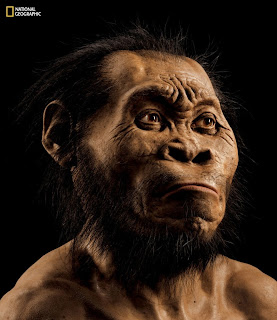September 10, 2015
By Amy Ellis Nutt
A new species of human relative, (click here) called Homo naledi, has been discovered deep in a cave in South Africa, it was announced Thursday morning at a press conference in Johannesburg. Three men who led the expedition took part in a Q & A with the National Geographic Society about how the fossils were found, their excavation and their two-year analysis by teams of international experts as to their place in human evolution. Below is a selection of those questions and answers from Lee Berger, an archaeologist and the leader of the expedition, John Hawks, an anthropologist and Paul Dirks, a geologist:...
1. What happens if H. naledi is very old? Or very young?
That ain't no monkey. The question is how far back does human intelligence go. The discovery of ART is an expression of intelligence, status and memory. There is more and more information about a society in South Africa that lends itself to understanding 'the human.' The archaeologic find of art within a cave reflects the early human was sophisticated. It has long been believed 'the human' had a different development than the Neanderthal.
The remains of an early human and the art were both found in caves.
September 17, 2010
By Dalya Alberge
Striking prehistoric rock art created up to 5,000 years ago (click here) has been discovered at almost 100 sites in Somaliland on the Gulf of Aden in eastern Africa.
A local team headed by Dr Sada Mire, of the Institute of Archaeology at University College London (UCL), made the finds, which include a man on horseback, painted around 4,000 years ago – one of the earliest known depictions of a mounted hunter.
Leaping antelopes, prancing giraffes and snakes poised to strike are among animals and reptiles depicted with astonishing clarity.
Such is the quality of the paintings that at least 10 sites, scattered across semi-desert terrain, are likely to be given World Heritage status....
By Amy Ellis Nutt
A new species of human relative, (click here) called Homo naledi, has been discovered deep in a cave in South Africa, it was announced Thursday morning at a press conference in Johannesburg. Three men who led the expedition took part in a Q & A with the National Geographic Society about how the fossils were found, their excavation and their two-year analysis by teams of international experts as to their place in human evolution. Below is a selection of those questions and answers from Lee Berger, an archaeologist and the leader of the expedition, John Hawks, an anthropologist and Paul Dirks, a geologist:...
1. What happens if H. naledi is very old? Or very young?
That ain't no monkey. The question is how far back does human intelligence go. The discovery of ART is an expression of intelligence, status and memory. There is more and more information about a society in South Africa that lends itself to understanding 'the human.' The archaeologic find of art within a cave reflects the early human was sophisticated. It has long been believed 'the human' had a different development than the Neanderthal.
The remains of an early human and the art were both found in caves.
September 17, 2010
By Dalya Alberge
Striking prehistoric rock art created up to 5,000 years ago (click here) has been discovered at almost 100 sites in Somaliland on the Gulf of Aden in eastern Africa.
A local team headed by Dr Sada Mire, of the Institute of Archaeology at University College London (UCL), made the finds, which include a man on horseback, painted around 4,000 years ago – one of the earliest known depictions of a mounted hunter.
Leaping antelopes, prancing giraffes and snakes poised to strike are among animals and reptiles depicted with astonishing clarity.
Such is the quality of the paintings that at least 10 sites, scattered across semi-desert terrain, are likely to be given World Heritage status....

